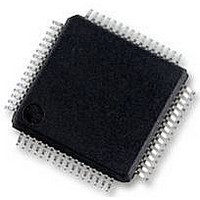UPD78F0890GK(A)-GAJ-AX NEC, UPD78F0890GK(A)-GAJ-AX Datasheet - Page 482

UPD78F0890GK(A)-GAJ-AX
Manufacturer Part Number
UPD78F0890GK(A)-GAJ-AX
Description
8BIT MCU, 128K FLASH, 7K RAM, LQFP
Manufacturer
NEC
Datasheet
1.UPD78F0890GKA-GAJ-AX.pdf
(732 pages)
Specifications of UPD78F0890GK(A)-GAJ-AX
Controller Family/series
UPD78F
No. Of I/o's
55
Ram Memory Size
7KB
Cpu Speed
20MHz
No. Of Timers
10
No. Of Pwm
RoHS Compliant
Core Size
8bit
Program Memory Size
128KB
Oscillator Type
External, Internal
- Current page: 482 of 732
- Download datasheet (4Mb)
16.14 Time Stamp Function
a consequence, the clocks of the nodes have no relation (i.e., the clocks are asynchronous and may have different
frequencies).
build up a global time base, a time stamp function is used. The essential mechanism of a time stamp function is the
capture of timer values triggered by signals on the CAN bus.
16.14.1 Time stamp function
timer unit in a microcontroller system is used in addition to the CAN controller. The 16-bit capture timer unit captures
the timer value according to a trigger signal (TSOUT) for capturing that is output when a data frame is received from
the CAN controller. The CPU can retrieve the time of occurrence of the capture event, i.e., the time stamp of the
message received from the CAN bus, by reading the captured value. TSOUT signal can be selected from the
following two event sources and is specified by the TSSEL bit of the C0TS register.
timing diagram, the SOF is used as the trigger event source). To capture a timer value by using TSOUT signal, the
capture timer unit must detect the capture signal at both the rising edge and falling edge.
TSOUT bit toggles upon occurrence of the selected event. If TSLOCK bit is set to 1, TSOUT toggles upon occurrence
of the selected event, but the toggle is stopped as the TSEN bit is automatically cleared to 0 as soon as the message
storing to the message buffer 0 starts. This suppresses the subsequent toggle occurrence by TSOUT, so that the
time stamp value toggled last (= captured last) can be saved as the time stamp value of the time at which the data
frame was received in message buffer 0.
482
CAN is an asynchronous, serial protocol. All nodes connected to the CAN bus have a local, autonomous clock. As
In some applications, however, a common time base over the network (= global time base) is needed. In order to
The CAN controller supports the capturing of timer values triggered by a specific frame. An on-chip 16-bit capture
- SOF event (start of frame)
- EOF event (last bit of end of frame) (TSSEL = 1)
The TSOUT signal is enabled by setting the TSEN bit of the C0TS register to 1.
TSOUT signal toggles its level upon occurrence of the selected event during data frame reception (in the above
This time stamp function is controlled by the TSLOCK bit of the C0TS register. When TSLOCK is cleared to 0,
TSOUT
SOF
Figure 16-35. Timing Diagram of Capture Signal TSOUT
(TSSEL = 0)
SOF
CHAPTER 16 CAN CONTROLLER
User’s Manual U17554EJ4V0UD
SOF
SOF
t
Related parts for UPD78F0890GK(A)-GAJ-AX
Image
Part Number
Description
Manufacturer
Datasheet
Request
R

Part Number:
Description:
16/8 bit single-chip microcomputer
Manufacturer:
NEC
Datasheet:

Part Number:
Description:
Dual audio power amp circuit
Manufacturer:
NEC
Datasheet:

Part Number:
Description:
Dual comparator
Manufacturer:
NEC
Datasheet:

Part Number:
Description:
MOS type composite field effect transistor
Manufacturer:
NEC
Datasheet:

Part Number:
Description:
50 V/100 mA FET array incorporating 2 N-ch MOSFETs
Manufacturer:
NEC
Datasheet:

Part Number:
Description:
6-pin small MM high-frequency double transistor
Manufacturer:
NEC
Datasheet:

Part Number:
Description:
6-pin small MM high-frequency double transistor
Manufacturer:
NEC
Datasheet:

Part Number:
Description:
6-pin small MM high-frequency double transistor
Manufacturer:
NEC
Datasheet:

Part Number:
Description:
6-pin small MM high-frequency double transistor
Manufacturer:
NEC
Datasheet:

Part Number:
Description:
Twin transistors equipped with different model chips(6P small MM)
Manufacturer:
NEC
Datasheet:

Part Number:
Description:
Bipolar analog integrated circuit
Manufacturer:
NEC
Datasheet:










